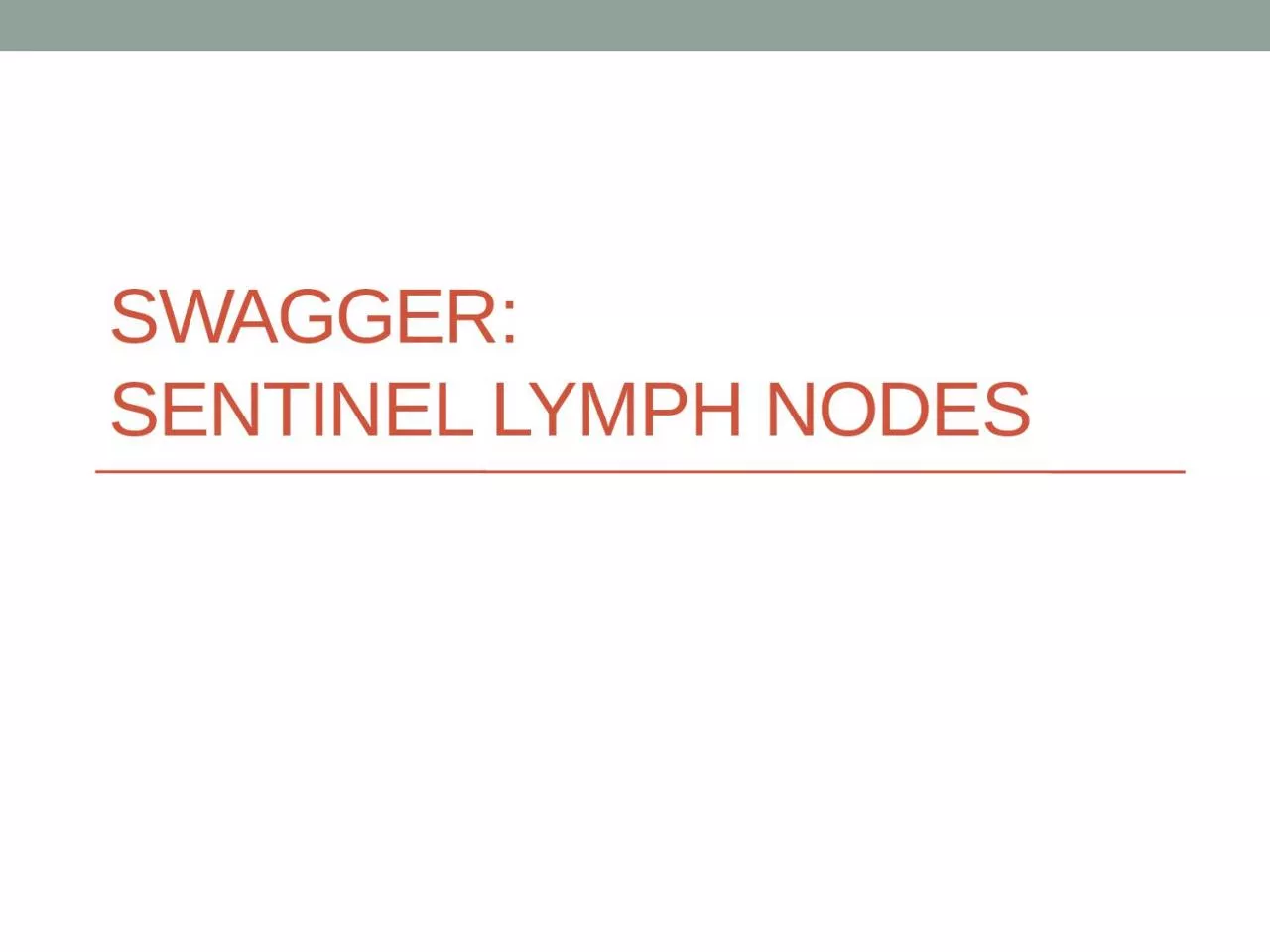

Summary Sentinel lymph node practice across SWAGGER Preliminary data SWAGGER SLN Endometrial cancer BGCS guidelines SLN PORTEC 3 SWAGGER SLN endometrial cancer Exeter SLN for G3 endometrial cancer ID: 1041122
Download Presentation The PPT/PDF document "Swagger: sentinel lymph nodes" is the property of its rightful owner. Permission is granted to download and print the materials on this web site for personal, non-commercial use only, and to display it on your personal computer provided you do not modify the materials and that you retain all copyright notices contained in the materials. By downloading content from our website, you accept the terms of this agreement.
1. Swagger: sentinel lymph nodes
2. SummarySentinel lymph node practice across SWAGGERPreliminary data: SWAGGER SLN Endometrial cancerBGCS guidelines SLNPORTEC 3
3. SWAGGER SLN endometrial cancer
4.
5. Exeter:SLN for G3 endometrial cancer72 cases – 6 recurrences, 4 deathsCheltenham:No SLNFull pelvic lymphadenectomy G319 cases – 12 had full pelvic lymphadenectomy1/12 (8.3%) positive nodes – chemotherapy. Distant recurrence and died
6. Bristol:40 cases G2 and G39/40 (22.5%) only unilateral SLN mapped31/40 (77.%%) SLN mapped bilaterallyPosition of SLN:External iliac 35Internal iliac 11Common iliac 4Obturator 18Parametrial 314 cases G2 – 1/14 (7%) positive SLN, had chemotherapy26 cases G3 – 1/26 (4%) positive SLN, had chemotherapy
7. Bristol 40 cases SLN G2/3 continued:6 recurrences – 3 local, 3 distant3 deaths
8. BGCS guidelines Sentinel nodes Vulval Cancer:Techniques TC99 with blue dye Not enough evidence for ICGHistological ultra-staging for SLNUnifocal tumours <4cm with no suspicious lymph nodes (clinical or examination) SLN standard of careIf no SLN detected then full lymphadenectomy
9. Cervical cancerTechniques TC99 with blue dye or ICGHistological ultra-staging for SLNSLN algorithms can be considered stage 1a1 with LVSI,Stage 1a2-1b1 (tumours less than 2cm)If no SLN detected then full lymphadenectomy
10. Int J Gynecol Cancer 2017;27: 154Y158)pooled detection rate of 89.2% (95% CI, 86.3Y91.6) pooled sensitivity rate of 90% (95% CI, 88Y92)Tumours<2cm sensitivity 96-100%
11. Endometrial cancer:Cervical injection for SLNTechniques TC99 with blue dye or ICGHistological ultra-staging for SLNCan be considered in high risk endometrial cancer (clear cell, serous, grade 3 endometrioid, carcinosarcoma)If no SLN detected then full lymphadenectomy
12. Lancet Oncol 2017; 18: 384–92. 10 centres in USAAny grade, apparent stage 1 endometrial cancerICG dye used, injected into cervixPAN 58%293/340 (86%) successful mapping177/340 (52%) bilateral mapping SLN
13.
14. ResultsThe sensitivity was 97·2% (95% CI 85·0–100; McNemar’s p=1). False-negative rate 3%Negative predictive value of 99·6% (95% CI 97·9–100). Isolated Para-aortic SLN detected 3/340 (<1%)6 patients (17%) had positive SLN outside conventional lymphadenectomy
15. Lancet Oncol (july) 2019; 20: 1273–85Between 2006-2013 660 women randomisedstage I endometrioid grade 3 cancer with deep myometrial invasion or lymphovascular space invasion, or both; stage II or III disease; orstage I–III disease with serous or clear cell histologyReceive radiotherapy alone (48·6 Gy in 1·8 Gy fractions given on 5 days per week) orChemoradiotherapy (two cycles of cisplatin 50 mg/m² given intravenously during radiotherapy, followed by four cycles of carboplatin AUC5 and paclitaxel 175 mg/m² given intravenously
16.
17. 5-year overall survival was 81·4% (95% CI 77·2–85·8) with chemoradiotherapyversus 76·1% (71·6–80·9) with radiotherapy alone (adjusted hazard ratio [HR] 0·70 [95% CI 0·51–0·97], p=0·034)
18. 5-year failure-free survival was 76·5% (95% CI 71·5–80·7) versus 69·1% (63·8–73·8; HR 0·70 [0·52–0·94],p=0·016).
19. stage III endometrial cancer, 5-year overall survival was 78.5% (95% CI 72.2–85.4)with chemoradiotherapy versus 68.5% (61.2–76.7)with radiotherapy alone (HR 0・63 [95% CI 0.41–0.99]; p=0.043)
20. In women with stage I–II disease,5-year overall survival was 83・8% (95% CI 78・4–89・5) with chemoradiotherapyversus 82・0% (95% CI 76・5–87・7) with radiotherapy alone HR 0・84 [95% CI 0・52–1・38]; p=0・50), 5-year failure-free survival was 81・3% (95% CI 74・7–86・3)with chemoradiotherapy versus 77・3% (95% CI 70・5–82・7) with radiotherapy alone (HR 0・87 [95% CI 0・56–1・36]; p=0・54;
21. 5-year overall survival was 71・4% (95% CI 60・1–84・7) with chemoradiotherapy versus 52・8% (40・6–68・6) with radiotherapy alone (HR 0・48 [95% CI 0・24–0・96]; p=0・037) 5-year failure-free survival was 59・7% (95% CI 45・1–71・6) with chemotherapyversus 47・9% (33・9–60・6) with radiotherapy alone (HR 0・42 [95% CI 0・22–0・80]; p=0・008
22. Results - recurrencesDistant metastases 78 of 330 women (5-year probability 21·4%; 95% CI 17·3–26·3) in the chemoradiotherapy group versus 98 of 330 (5-year probability 29·1%; 24·4–34·3) in the radiotherapy-alone group (HR 0·74 [95% CI 0·55–0·99]; p=0·047).Isolated vaginal recurrence was the first site of recurrence in one patient (0·3%; 95% CI 0·0–2·1) in both groups (HR 0·99[95% CI 0·06–15·90]; p=0·99)isolated pelvic recurrence was the first site of recurrence in three women (0·9%[95% CI 0·3–2·8]) in the chemoradiotherapy group versus four (0·9% [95% CI 0·3–2·8]) in the radiotherapy-alone group (HR 0·75 [95% CI 0·17–3·33]; p=0·71)
23. Result – adverse side effectsAt 5 years, only one grade 4 adverse event (ileus or obstruction) was reported (in the chemoradiotherapy group).grade 3 adverse events did not differ significantly between the two groups, occurring in 16 (8%) of 201 women in the chemoradiotherapy group versus ten (5%) of 187 in the radiotherapy-alone group (p=0·24).grade 3 adverse event was hypertension (in four [2%] women in both groups).grade 2 or worse adverse events were reported in 76 (38%) of 201 women in the chemoradiotherapy group versus 43 (23%) of 187 in the radiotherapy-alone group (p=0·002).Sensory neuropathy persisted more often after chemoradiotherapy than after radiotherapy alone, with 5-year rates of grade 2 or worse neuropathy of 6% (13 of 201 women) versus 0% (0 of 187). No treatment-related deaths were reported.